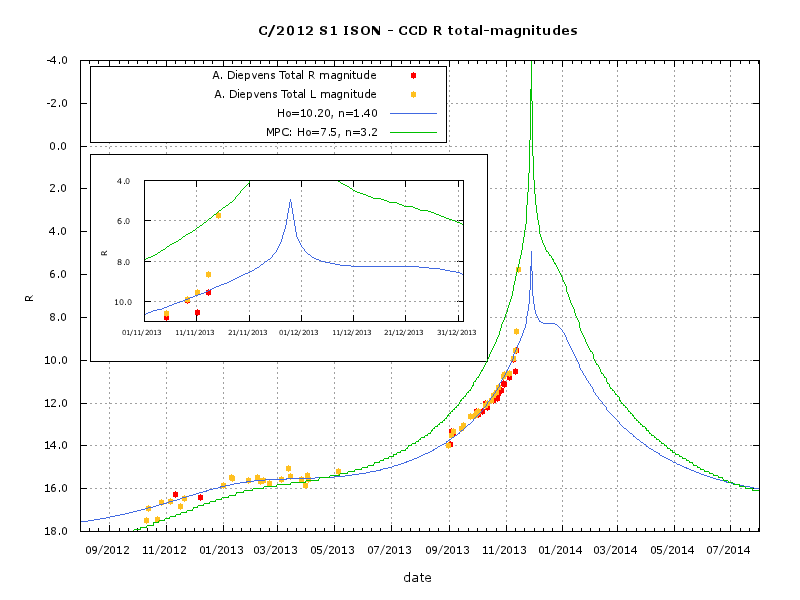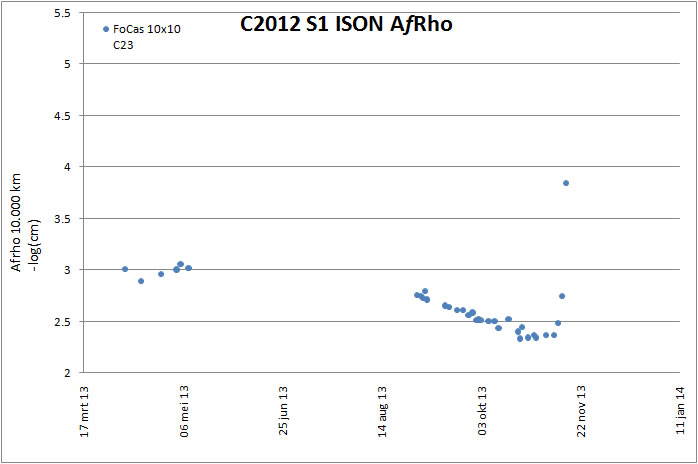Copyright © 2009 / 2012 - Alfons Diepvens - all rights reserved.
C2012 S1 ISON NEO AS03D20
New update: 15 Nov 2013
Eric Broens provided a new light curve for the total coma brightness and the following information.
Up to mid October the total coma magnitudes obtained with a Cousins R filter did not differ significantly
from those obtained from the unfiltered CCD observations.
From then on the unfiltered observations were increasingly brighter than those obtained with the Rc filter, as is shown in the Rc-L "color-curve".
On November 5th and November 9th however, the Rc-L value decreased again, while on November 11th, just prior to the outburst, the Rc-L value suddenly increased to 1 magnitude.
Although the Rc image doesn't show anything unusual, it looked like the Rc observation of November 11th was a discrepant one, since the comet faded by about 0.5 magnitude in Rc, while unfiltered the comet brightened at the expected pace.
On November 13th, at the start of the outburst, Rc-L = 0.9, consistent with the observation of November 11th. Unfortunately no Rc image could be obtained on November 15th, was the fading in the Rc band on November 11th real?
New best fit update: 30 Oct 2013
Eric Broens calculated a new best fit for the total coma brightness measurements he obtained from my images. The newly photometric parameters are Ho=10.2 +/- 0.05 and n=1.40 +/- 0.04. Both Ho and n are slightly smaller than the previously obtained values based on observations until September 24th.
15 Oct. 2013
In order to obtain the total coma brightness, Eric Broens re-measured all my images
and provided a new graph. In this graph the total coma brightness,
expressed in CCD R magnitudes, are plotted as red dots.
The blue line represents the best fit through my observations, with the resulting photometric parameters Ho=9.90 +/- 0.06 and n = 1.55 +/- 0.06, the yellow line represents the predicted visual magnitude taken from the MPC ephemerides (Ho=7.5, n=3.2). The new fit (blue line) suggests that the comet will reach a peak brightness
of R-magnitude 4 by the end of November, and then will fade rapidly to R-magnitude 8 in about 10 days. However, the peak brightness that comet ISON eventually will reach remains an open question, as comets are unpredictable. The comet still might brighten more rapidly or slowly than the model curve currently predicts. The previous graph published on this website, displaying the FoCAs photometry
in a 10x10 arcseconds aperture together with the predicted light curve from the MPC ephemerides, caused some confusion regarding the comet’s peak brightness. The brightness measurements displayed in that graph are measured in a square aperture of 10 x 10 arcseconds centered on the central part of the coma. With the apparent coma diameter growing larger as the comet approaches the sun and the earth, the square aperture of 10x10 arcseconds does not include all the light of the comet’s coma. The image of September 15th already displayed a coma of about 40 arcseconds. Therefore these brightness measurements underestimated the total brightness of the comet’s coma.
Eric Broens provided a new light curve for the total coma brightness and the following information.
Up to mid October the total coma magnitudes obtained with a Cousins R filter did not differ significantly
from those obtained from the unfiltered CCD observations.
From then on the unfiltered observations were increasingly brighter than those obtained with the Rc filter, as is shown in the Rc-L "color-curve".
On November 5th and November 9th however, the Rc-L value decreased again, while on November 11th, just prior to the outburst, the Rc-L value suddenly increased to 1 magnitude.
Although the Rc image doesn't show anything unusual, it looked like the Rc observation of November 11th was a discrepant one, since the comet faded by about 0.5 magnitude in Rc, while unfiltered the comet brightened at the expected pace.
On November 13th, at the start of the outburst, Rc-L = 0.9, consistent with the observation of November 11th. Unfortunately no Rc image could be obtained on November 15th, was the fading in the Rc band on November 11th real?
New best fit update: 30 Oct 2013
Eric Broens calculated a new best fit for the total coma brightness measurements he obtained from my images. The newly photometric parameters are Ho=10.2 +/- 0.05 and n=1.40 +/- 0.04. Both Ho and n are slightly smaller than the previously obtained values based on observations until September 24th.
15 Oct. 2013
In order to obtain the total coma brightness, Eric Broens re-measured all my images
and provided a new graph. In this graph the total coma brightness,
expressed in CCD R magnitudes, are plotted as red dots.
The blue line represents the best fit through my observations, with the resulting photometric parameters Ho=9.90 +/- 0.06 and n = 1.55 +/- 0.06, the yellow line represents the predicted visual magnitude taken from the MPC ephemerides (Ho=7.5, n=3.2). The new fit (blue line) suggests that the comet will reach a peak brightness
of R-magnitude 4 by the end of November, and then will fade rapidly to R-magnitude 8 in about 10 days. However, the peak brightness that comet ISON eventually will reach remains an open question, as comets are unpredictable. The comet still might brighten more rapidly or slowly than the model curve currently predicts. The previous graph published on this website, displaying the FoCAs photometry
in a 10x10 arcseconds aperture together with the predicted light curve from the MPC ephemerides, caused some confusion regarding the comet’s peak brightness. The brightness measurements displayed in that graph are measured in a square aperture of 10 x 10 arcseconds centered on the central part of the coma. With the apparent coma diameter growing larger as the comet approaches the sun and the earth, the square aperture of 10x10 arcseconds does not include all the light of the comet’s coma. The image of September 15th already displayed a coma of about 40 arcseconds. Therefore these brightness measurements underestimated the total brightness of the comet’s coma.
update: Focas 10x10 lightcurve - Afrho15-11-2013 : see belowUpdate 15 Nov 2013



